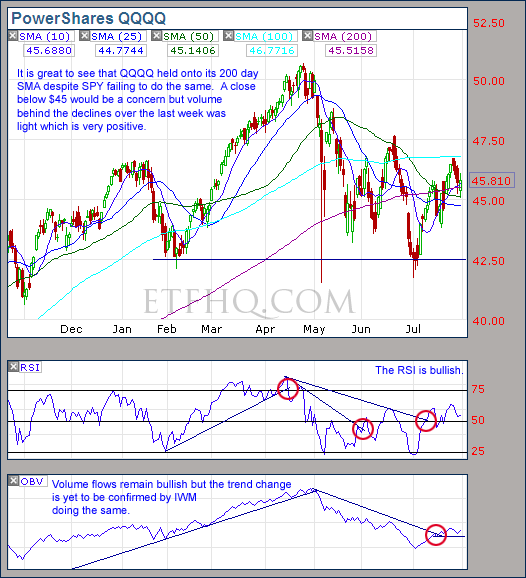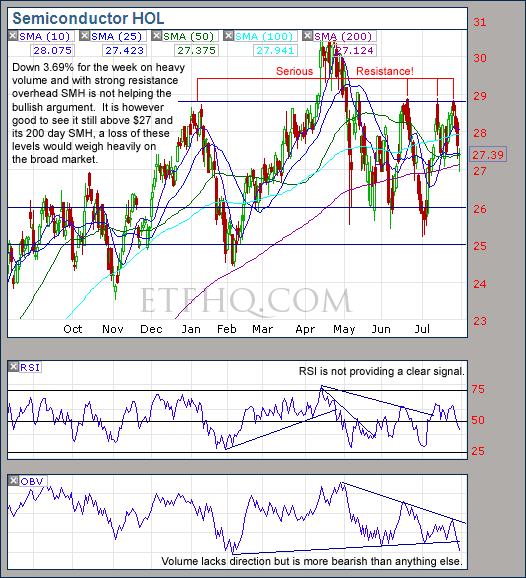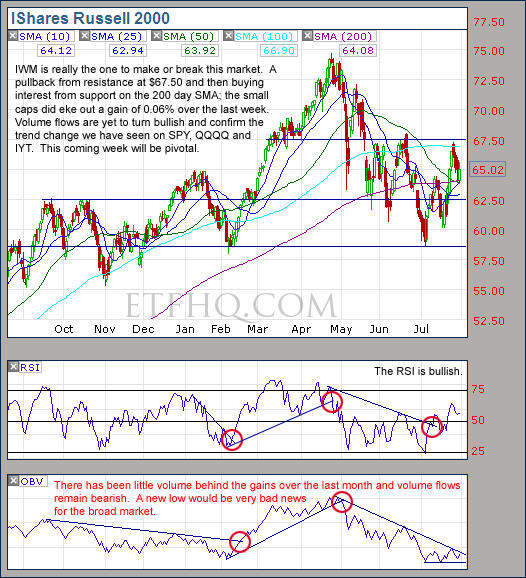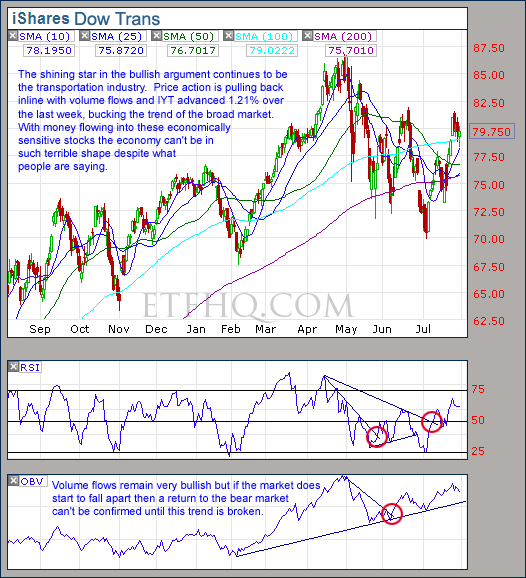August 02, 2010 – 02:40 am EDT
August, 2010? Doesn’t that sound the opening dialogue of some sci-fi film set in the distant future where we all drive cars that float? Anyway, over the last week there were some good bits and some bad bits but the declines were small and no real technical damage has been done… yet. If we are going to see a trend change however, time is running out so the bulls must step up to the mark very soon.
****Thanks to all those who referred people to this newsletter over the last week, sharing is caring.
.
ETF % Change Comparison
.

This market doesn’t like to make life easy does it? It is exceptionally positive to see the Transports (IYT) bucking the trend and advancing a healthy 1.21% while it is concerning to see the Semiconductors (SMH) fall 3.69% for the week. These conflicting internals are one of the reasons why a trend is finding it so difficult to develop.
.
What the % Comparison Table Tells Us:
By comparing the performance of the economically sensitive (SMH, QQQQ, IWM, IYT) and the comparatively stable ETFs (SPY and DIA) we can get an indication of the true market direction. The more sensitive areas of the market tend to be the first to initiate a trend change. For example if DIA and SPY sell off heavily while SMH and IWM (Russell 2000 small cap ETF) sell of mildly or continue moving to new highs then this would be very positive and vice versa.
The ‘Average Rank %’ is calculated by subtracting the % change for each ETF from the maximum % change and dividing it by the range for each period. 1-((MAX(% change all ETFs)-ETFs % Change)/(MAX(% change all ETFs)-MIN(% change all ETFs))) The readings for each period are then averaged. This reading is provided because if one ETF was significantly under/out performing the others then a plain high or low rank would not accurately reflect this.
.
![]()
.
A Look at the Charts
.

Heavy volume behind the declines on SPY last week are not a good look but the performance of QQQQ carries more weight.
.

QQQQ continues to outperform SPY which is positive but a close below $45 will cause problems.
.

SMH is still holding onto $27 but the volume behind the declines over the last week was very heavy.
.

Will we see the Small Caps lead the market higher or not? Keep an eye on that volume trend.
.

FedEx shares climbed 5.6% on Monday on good earnings which helps to explain why the volume into IYT has been so strong for the last two months. Such performance requires the moving of goods and goods are only moved when goods are sold and this is a positive sign for the economy. So if the market does start to fall apart and support levels begin to fail then a return to the bear market can’t be confirmed until volume flows on IYT turn negative.
.
![]()
.
OM3 Weekly Indicator
.

The OM3 indicator is not very enthusiastic and suggests that the weekly cycle is still moving up but within a bear market.
.
How to read the OM3 indicator
The OM3 indicator as with most of our models primarily reads price action and volume. The strong/weak buy/sell signals are self-explanatory. ‘No Signal’ means that the component readings are in conflict and cancel each other out.
The alerts let you know if the cycle is speeding up or slowing down, so when you get at ‘Strong Buy, Bear Alert’ for instance it simply means that the criteria for a strong buy is in place but this weeks cycle reading is weaker (or more bearish) than last weeks reading (the same is true in reverse).
The number of weeks that a signal has been repeated is displayed. Historically a ‘Strong Buy’ signal has lasted for an average of 6 weeks and a maximum of 42 weeks, while a ‘Strong Sell’ has lasted for an average of 4 weeks and a maximum of 16.
This is an indicator not a mechanical trading model. It is useful to assist in analyzing the market but for the best results should be combined with commonsense and support/resistance levels etc.
.
![]()
.
TransDow & NasDow
.

The Transports remain dominant over the Dow and are showing a small profit after one week. The Dow has just emerged as the dominant index over the NASDAQ which is not a positive sign.
.
What the TransDow Readings tell us:
The TransDow measures dominance between the DJ Transportation Index (DJTI) and the Dow Jones Industrial Average (DJIA). In a strong market the more economically sensitive Transportation Index should be dominant over the DJIA.
Historically the DJTI has been dominant over the Dow 45% of the time. The annualized rate of return from the DJTI during this period was 18.47% with the biggest loss for one trade sitting at -13.27%. The annualized return from the DJIA during the periods it was dominant over the DJTI was just 4.06% and the biggest loss for one trade was -16.13%. A 4% stop-loss is applied to all trades adjusting positions only at the end of the week.
What the NasDow Readings tell us:
The NasDow measures dominance between the NASDAQ and the DJIA. Using the same theory behind the Trans Dow; in a strong market the more economically sensitive NASDAQ should be dominant over the DJIA.
Historically the NASDAQ has been dominant over the DJIA 44% of the time. Taking only the trades when the NASDAQ is above its 40 week moving average the annualized rate of return was 25.47% with the biggest loss for one trade sitting at –8.59%. The annualized rate on the DJIA during the periods it was dominant over the NASDAQ is just 8.88% and the biggest loss for one trade was –12.28%. A 8% stop-loss is applied to all trades adjusting positions only at the end of the week.
.
![]()
.
LTMF 80 & Liquid Q
.

Both LTMF 80 and Liquid Q remain in cash.
.
Historical Stats:
.

.
How The LTMF 80 Works
LTMF stands for Long Term Market Forecaster. It reads volume flows relative to price action and looks for out performance of volume measured on a percentage basis over the prior 12 months. During a sustained rally the readings will reach high levels (near 100%) making it imposable for the volume reading to always outperform price so any reading above 80% will maintain the buy signal. This system has outperformed the market over the last 10 years but performance has been damaged by some nasty losses. It only produces buy signals and only for QQQQ.
How Liquid Q Works
Liquid Q completely ignores price action and instead measures the relative flow of money between a selection of economically sensitive and comparatively stable ares of the market. It looks for times when the smart money is confident and and can be seen by through volume investing heavily is more risky areas due to an expectation of expansion. This system has outperformed the market over the last 10 years and remained in cash through most of the major declines. It only produces buy signals and only for QQQQ. We will provide more performance details on the web site for these systems soon.
.
![]()
.
Summary
I said last week that “If the 200 Day SMAs start falling and SMH closes below $27 then prospects of a trend change are probably dead and burred for the time being.” This is still the case but I would add that if volume flows on IYT turn bearish then we have returned to the bearish market. I still have faith in the bullish prospects but a return to be bull market will need to to be confirmed by a trend change in volume flows on IWM while QQQQ and SMH continue to hold onto their 200 day SMAs. In the interim the market remains in limbo and we would all be wise to remain patient.
.
Any disputes, questions, queries, comments or theories are most welcome in the comments section below.
.
Derry
And the Team @ ETF HQ
“Equipping you to win on Wall St so that you can reach your financial goals.”
.
P.S Like ETFHQ on Facebook – HERE
.
![]()
.
Poem of the Day:
Lose this day loitering – ’twill be the same story
To-morrow – and the next more dilatory;
Each indecision brings its own delays,
And days are lost lamenting o’er lost days,
Are you in earnest? Sieze this very minute –
Boldness has genius, power and magic in it.
Only engage, and then the mind grows heated –
Begin it, and then the work will be completed!
– Johann Wolfgang Von Goethe (1749 – 1832)